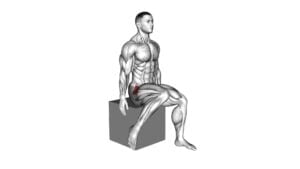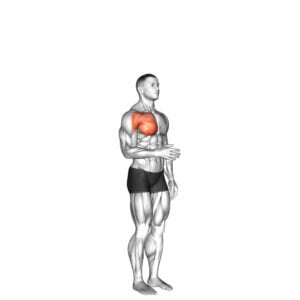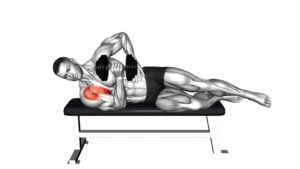Suspender Internal Rotation – Video Exercise Guide & Tips

Looking to improve your internal rotation? Check out our video exercise guide for Suspender Internal Rotation.
Watch This Exercise Video
This quick and effective routine will help you strengthen and mobilize your muscles. Learn the proper equipment and set up, along with step-by-step instructions to perform the exercise correctly. Avoid common mistakes and maximize the effectiveness of this movement with our helpful tips.
Whether you're a beginner or an advanced user, we've got variations and progressions for everyone.
Let's get started!
Key Takeaways
- Suspender internal rotation exercise improves shoulder mobility and stability.
- It targets the muscles in the rotator cuff and strengthens the muscles responsible for internal rotation.
- This exercise enhances overall shoulder function and is particularly beneficial for athletes or individuals with a wide range of shoulder motion.
- Maintaining proper form, control, and avoiding jerky or fast movements is crucial for performing this exercise effectively.
Benefits of Suspender Internal Rotation
You will experience improved shoulder mobility and stability with the benefits of suspender internal rotation. This exercise technique targets the muscles in your rotator cuff, specifically the muscles responsible for internal rotation of the shoulder joint. By performing suspender internal rotation exercises, you can strengthen these muscles, which will help to enhance your overall shoulder function.
One of the key benefits of suspender internal rotation is increased shoulder mobility. As you strengthen and activate the muscles involved in internal rotation, you'll find that your range of motion in this movement improves. This can be particularly beneficial for athletes or individuals involved in activities that require a wide range of shoulder motion, such as throwing or swinging a racket.
In addition to improved mobility, suspender internal rotation also helps to enhance shoulder stability. The muscles targeted in this exercise are important for stabilizing the shoulder joint, which can help to prevent injuries and improve overall shoulder strength.
To perform suspender internal rotation, attach a resistance band or suspension trainer to a fixed point, such as a door handle or bar. Stand facing the anchor point and grip the band or handles with your arms in front of you. Keeping your elbows tucked in, rotate your forearms inward, bringing your hands toward your belly button. Slowly return to the starting position and repeat for the desired number of repetitions.
Equipment and Setup for the Exercise
To set up for the suspender internal rotation exercise, you'll need to attach a resistance band or suspension trainer to a fixed point, such as a door handle or bar. This equipment setup ensures that you have a stable anchor point to perform the exercise effectively.
Once you have attached the resistance band or suspension trainer, stand facing the anchor point with your feet shoulder-width apart. Hold onto the handles or straps with both hands, keeping your elbows bent at a 90-degree angle.
Next, position your body correctly for the exercise. Keep your chest up, shoulders back, and core engaged to maintain stability throughout the movement. It's important to maintain proper posture to target the muscles effectively and prevent strain or injury.
To perform the exercise, start by keeping your upper arms parallel to the floor. Then, slowly rotate your forearms inwards, bringing your hands towards the midline of your body. Pause for a moment at the end of the range of motion and then return to the starting position.
Remember to perform the exercise with control and avoid any jerky or fast movements. Focus on engaging the targeted muscles and maintaining proper form throughout the exercise.
Step-by-Step Guide to Perform Suspender Internal Rotation
To perform the suspender internal rotation exercise, begin by standing facing the anchor point with your feet shoulder-width apart and holding onto the handles or straps with both hands, elbows bent at a 90-degree angle. Engage your core to maintain stability throughout the exercise.
Keeping your upper arms parallel to the ground, slowly rotate your forearms inward, bringing your hands towards your midline. Pause for a brief moment at the end range of motion, then slowly return to the starting position.
This exercise targets the internal rotators of the shoulders and helps to improve shoulder stability and mobility. It also activates the muscles in the upper back and improves posture.
Setting up the equipment properly is crucial to ensure safety and effectiveness. Make sure the anchor point is secure and at a height that allows you to maintain proper form. Adjust the straps or handles to a length that allows your arms to be at a 90-degree angle when your hands are at your midline.
Now, let's move on to the next section to learn about common mistakes to avoid when performing the suspender internal rotation exercise.
Common Mistakes to Avoid
Continuing from the previous subtopic, it's important to be aware of common mistakes to avoid when performing the suspender internal rotation exercise. To ensure that you get the most out of this exercise and reduce the risk of injury, it's crucial to maintain proper form throughout.
One common mistake is using too much weight. It's essential to start with a weight that allows you to perform the exercise with proper form. Using excessive weight can lead to compromised technique and potential strain on your muscles and joints. Remember, the goal is to focus on the targeted muscles and not on lifting heavy weights.
Another common mistake is rushing through the exercise. Performing the suspender internal rotation exercise with fast, jerky movements can hinder its effectiveness and increase the risk of injury. Instead, take your time and concentrate on the proper execution of each repetition. Slow and controlled movements will engage the muscles more effectively and yield better results.
Lastly, improper positioning of the body can also be a mistake. Ensure that you maintain a stable and balanced stance throughout the exercise. Keep your core engaged, shoulders relaxed, and maintain a neutral spine. This proper alignment will help you target the intended muscles and prevent unnecessary strain on other parts of your body.
Tips to Maximize the Effectiveness of the Exercise
To maximize the effectiveness of the Suspender Internal Rotation exercise, it's important to focus on proper form techniques. Ensure that your body is aligned correctly and that you're engaging the targeted muscles throughout the movement.
Additionally, incorporating proper breathing techniques can help stabilize your core and enhance the overall effectiveness of the exercise.
Proper Form Techniques
Start by positioning yourself in a comfortable standing position with your feet shoulder-width apart. Maintaining proper form techniques is crucial for maximizing the effectiveness of the Suspender Internal Rotation exercise.
Here are three tips to ensure you perform this exercise correctly:
- Keep your core engaged throughout the movement to maintain stability and prevent excessive spinal rotation.
- Maintain a neutral spine position by avoiding excessive arching or rounding of the back.
- Focus on the movement of your shoulders, ensuring they rotate internally without any compensatory movements in the hips or lower body.
By following these proper form techniques, you can target the intended muscles effectively and reduce the risk of injury.
Now, let's move on to the next section, where we'll discuss breathing techniques for stability.
Breathing Techniques for Stability
To maximize the effectiveness of the exercise, focus on engaging your core and maintaining proper breathing techniques for stability.
Breathing techniques play a crucial role in maintaining core stability during the suspender internal rotation exercise. Proper breathing helps to activate the deep abdominal muscles and stabilize the spine, allowing for better control and balance throughout the movement.
When performing the exercise, inhale deeply through your nose, expanding your diaphragm and filling your lungs with air. As you exhale, engage your core muscles by drawing your belly button towards your spine. This contraction helps to stabilize your torso and maintain proper alignment.
Remember to breathe smoothly and rhythmically throughout the exercise, allowing your breath to guide and support your movements.
Variations and Progressions for Advanced Users
Now that you've mastered the basic exercise, it's time to take it to the next level with advanced progression options.
These variations and techniques are designed for experts like you who want to challenge themselves even further.
With advanced user modifications, you can continue to improve your strength, flexibility, and overall performance.
Advanced Progression Options
Take your suspender internal rotation exercises to the next level with these advanced progression options. Here are three advanced progression techniques and modifications for advanced users:
- Increase resistance: Attach additional weight plates or resistance bands to your suspender setup to challenge your muscles even more. This will increase the difficulty and intensity of the exercise, helping you build strength and improve your rotational control.
- Single-leg variation: Perform the suspender internal rotation exercise while standing on one leg. This unilateral movement will further engage your core and stabilizing muscles, as well as improve balance and coordination.
- Dynamic movements: Instead of performing the exercise in a static position, incorporate dynamic movements. For example, you can combine the internal rotation with lunges or squats to add a functional component to the exercise and mimic real-life movements.
Variation Techniques for Experts
As an advanced user of suspender internal rotation exercises, you can further enhance your workout with variation techniques that challenge your muscles and improve your overall strength.
There are several advanced progression options available to take your workout to the next level. One variation technique is to increase the resistance by using heavier weights or bands. This will intensify the exercise and provide a greater challenge for your muscles.
Another option is to incorporate stability exercises, such as performing the suspender internal rotation exercise on a stability ball or Bosu ball. This will engage your core muscles and improve your balance and stability.
Additionally, you can try performing the exercise in different positions, such as standing or kneeling, to target different muscle groups and add variety to your workout.
Advanced User Modifications
What are some ways you can modify suspender internal rotation exercises to challenge yourself as an advanced user?
As an advanced user, you can enhance your workout by incorporating advanced modifications and progression techniques into your suspender internal rotation exercises. Here are three ideas to help you take your workout to the next level:
- Increase the resistance: Use thicker resistance bands or add extra weight to increase the challenge and intensity of the exercise.
- Reduce stability: Perform the exercise on an unstable surface, such as a balance board or BOSU ball, to engage more muscles and improve your balance and core strength.
- Increase range of motion: Gradually increase the range of motion by extending your arms further away from your body during the exercise, allowing for a deeper rotation and increased muscle activation.
Frequently Asked Questions
How Long Should I Hold the Suspended Internal Rotation Position?
When performing the suspended internal rotation exercise, it's important to hold the position for an appropriate amount of time. The holding duration can vary depending on your fitness level and goals. It's generally recommended to hold the position for around 10-30 seconds to effectively engage the targeted muscles.
However, it's always best to consult with a fitness professional to determine the ideal holding duration for your specific needs.
Additionally, there are alternative exercises available that can target the same muscle groups if the suspended internal rotation isn't suitable for you.
Can I Perform the Exercise Without Using Suspenders?
Yes, you can perform the exercise without using suspenders. However, using suspenders provides added benefits such as stability and support, allowing you to target the muscles more effectively.
If you don't have suspenders, you can try alternative exercises that focus on internal rotation, such as using resistance bands or dumbbells. These exercises can still help strengthen and improve flexibility in your rotator cuff muscles.
Are There Any Precautions or Contraindications for Performing the Suspended Internal Rotation Exercise?
Before performing the suspended internal rotation exercise, it's important to be aware of any precautions or contraindications.
Precautions may include ensuring that you have the necessary strength and stability in your shoulder before attempting this exercise.
Contraindications may include any pre-existing shoulder injuries or conditions that could be aggravated by this movement.
It's always recommended to consult with a healthcare professional or a qualified fitness trainer to determine if this exercise is suitable for you.
How Often Should I Incorporate the Suspended Internal Rotation Exercise Into My Workout Routine?
To effectively incorporate the suspended internal rotation exercise into your workout routine, it's recommended to perform it at least 2-3 times a week. This frequency allows your muscles to adapt and improve.
By regularly incorporating suspended internal rotation, you can enhance shoulder stability, strengthen the rotator cuff muscles, and improve overall upper body strength.
Remember to start with lighter resistance and gradually increase as you become more comfortable and proficient with the exercise.
Can the Suspended Internal Rotation Exercise Help With Shoulder Impingement or Rotator Cuff Injuries?
The suspended internal rotation exercise can be a beneficial addition to your workout routine if you're dealing with shoulder impingement or rotator cuff injuries. It helps improve shoulder mobility and can aid in the rehabilitation process.
By targeting the rotator cuff muscles, this exercise can help strengthen and stabilize the shoulder joint, potentially reducing pain and improving overall function.
However, it's important to consult with a healthcare professional before incorporating this exercise into your routine to ensure it's safe for your specific condition.
Conclusion
In conclusion, suspender internal rotation is a beneficial exercise that can help improve shoulder strength and mobility.
By using suspenders and following the step-by-step guide, individuals can effectively perform this exercise.
It's important to avoid common mistakes and follow tips to maximize its effectiveness.
Advanced users can also explore variations and progressions to further challenge themselves.
Incorporating suspender internal rotation into a workout routine can contribute to overall shoulder health and fitness.

Author
Years ago, the spark of my life’s passion ignited in my mind the moment I stepped into the local gym for the first time. The inaugural bead of perspiration, the initial endeavor, the very first surge of endorphins, and a sense of pride that washed over me post-workout marked the beginning of my deep-seated interest in strength sports, fitness, and sports nutrition. This very curiosity blossomed rapidly into a profound fascination, propelling me to earn a Master’s degree in Physical Education from the Academy of Physical Education in Krakow, followed by a Sports Manager diploma from the Jagiellonian University. My journey of growth led me to gain more specialized qualifications, such as being a certified personal trainer with a focus on sports dietetics, a lifeguard, and an instructor for wellness and corrective gymnastics. Theoretical knowledge paired seamlessly with practical experience, reinforcing my belief that the transformation of individuals under my guidance was also a reflection of my personal growth. This belief holds true even today. Each day, I strive to push the boundaries and explore new realms. These realms gently elevate me to greater heights. The unique combination of passion for my field and the continuous quest for growth fuels my drive to break new ground.



